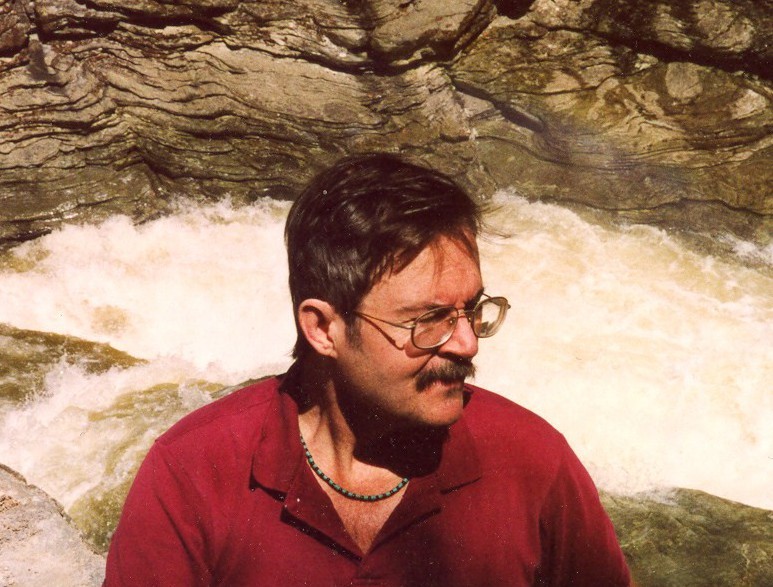Christopher Blake wants you to have a religious experience. In the sparsely populated hills between McDowell and Burke counties, nestled among the gem mining stores and antique barns, sits the geologic marvel that some call the “Grand Canyon of the East.” The sublime Linville Gorge, a jagged cut in the face of Appalachia, truly gives one a sense of the scale of these mountains. Blake’s book invites readers to encounter the spirit of “one of the earth’s enchanted places.”
In “River of Cliffs: A Linville Gorge History,” a new edition of a book originally published in 2005, Blake presents a collection of historical accounts — journal entries, news articles and other ephemera relating to experiences in what is now the Linville Gorge Wilderness Area. The introduction alternates between expansive poetic reflection and straightforward description of the physical landscape. But Blake’s overall attitude is captured in the first paragraph, where he says, “Here indeed is a primordial place, where man and his incursions seem puny and fleeting.“
For Blake, Linville Gorge is not something you see; it is something you experience. In his words, it can provide a “raw, direct sensuous experience” to those who are willing to enter it on its own terms.
But the book is much more than a litany of praise from past visitors to the gorge. It is a fascinating journey through the human history of one of America’s original wilderness areas, designated as such in 1964. The curious collection of documents reflects a diverse array of personal perspectives, sociological lenses, ideological convictions and natural histories.
The first chapter, “The Spangenberg Diary,” recounts the 1752 reconnaissance mission of a Moravian bishop to find a tract of land for large-scale settlement. His account reads like field notes, offering details on geologic formations, plant life, and animal habits and habitats. The descriptions conjure a nostalgic sense of the early American wild through matter-of-fact prose.
Many chapters throughout the book echo this perspective — a naturalist view that gives glimpses into the landscape and wildlife. Most of the authors of these entries didn’t contextualize what they saw in terms of human interaction, so the accounts feel as though they present a window directly onto the gorge itself.
Blake’s own history with the gorge goes back five decades, to a 1967 Outward Bound trip he took as a student at Lee H. Edwards High School (now Asheville High). One chapter of the book is composed of his field journal from that 26-day trip, and it stands in stark contrast to the writing style of the mature author. The journal of young Blake contains short, direct descriptions: “Wake up at 0600. Go on a run and dip.” They detail his experiences but do little to explore his impressions.
Blake’s introduction, in comparison, drips with description. “Every encounter with the Gorge and the Falls seems to leave me with a welter of vivid impressions,” he writes. The difference in focus mirrors what Blake describes as a goal of his book: depicting the magic of experiencing Linville Gorge.
“Appreciation,” Blake writes, “can be heightened by an awareness of what others have left in the way of testimonial to their wonder and respect for the place.” Not every chapter of the book describes simple awe, however; the gorge’s history includes more sinister aspects, as well.
Early chapters reveal that the gorge is named for William and John Linville. The book tells a version of the story where the father and son were members of a small hunting party in 1766 when they were attacked and killed by Shawnee raiders, probably from Georgia, ranging north to battle with the Cherokee. News of the deaths spread up the Eastern seaboard. The Pennsylvania Gazette decried the “inhuman custom” of supposed Cherokee fighters willing to kill whites as revenge for settlers killing Cherokees.
Other sections of the book discuss the area’s original inhabitants; however, they are all framed by the incursion of white settlers into a place that had been used for many thousands of years by indigenous peoples. Early violent encounters led to repressive government policies, with the ultimate outcome being forced removal in 1838.
The final chapter of the book deals with the life of Jane Blalock Holtsclaw, born to a Cherokee family that remained in North Carolina after the Indian Removal Act. She was a wise woman and healer, and after moving from traditional Cherokee lands west of Asheville into McDowell County, she made traditional medicine by wildcrafting in the gorge, alone on trips for weeks at a time.
The inclusion of such accounts in a book about a wilderness area reminds readers of the complex texture of intertwined physical and cultural history. Blake asks readers to “consider how the Gorge is mediated to them.” Tourism brochures exclaiming about hiking trails and trout fishing may lure visitors to a place for an experience of unforgettable rugged beauty, but they often don’t offer a broader context that would facilitate a holistic experience of place.
To Blake, this matters. He feels that managing people’s expectations and experiences of the natural world through various media cuts them off from the raw magic that characterizes the wilderness area. That is a large part of why he created this book: Blake wanted to offer a different kind of a map.
“River of Cliffs” invites readers into participatory historical cartography. Explore the accounts of Blake and so many others, then go and create your own entry for the annals of Linville Gorge Wilderness Area history.
Blake and Pete Whelihan, a local mycologist, will appear at Malaprop’s Bookstore on Aug. 14 at 7 p.m. to discuss the book, the gorge, and the interplay between radical social subcultures and engaging the natural world. The event will take a meta-approach to the notion of discussing a natural place as object versus subject. It will examine the implications of our tendencies to create narratives that speak for places, despite these places having their own unique histories independent of the speaker. The book will be available for purchase at the event or can be found online at arcadiapublishing.com. Blake also leads occasional guided trips in the gorge. He can be reached by email at gorgestalker@gmail.com.




It is a religious experience at the gorge.
I have seen the Brown Mtn lights. I have seen ghost dogs and even a ghost wedding. Saw a baboon once…tossed his PBR beer can out into space at Wizemunz View. Glad the county leaves the road a mess so the tourons only go to the Falls parking lot instead of tearing up their SUV chrome wheels.
I was wondering if there is more information on Bo Franklin and where the information on him in this book is taken form . Mr. Franklin is my husbands grandfather.